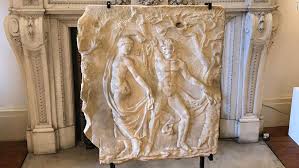Ancient looted art returned to Italy

Rome: Eight works of looted art — some thought to be more than 2,000 years old — have been returned to Italy by Christie’s auction house.
The Italian police had contacted Christie’s before the items were sold, asking for the lot to be withdrawn and returned.
Returning looted artifacts will finally restore heritage to the brilliant cultures that made them
The initiative marks a success for Rome’s long-standing efforts to repatriate antiquities it says were illegally obtained and trafficked. Christie’s said the items were “acquired in the past in good faith” and voluntarily returned them at a ceremony at the Italian embassy in London, which was attended by the country’s culture minister Alberto Bonisoli.
“The restitution confirms the effectiveness of the collaboration between our country and the giants of the art market such as Christie’s in the fight against illegal trafficking of works of art,” said Bonisoli, in a statement issued by the embassy.
“Those who buy a work of art or an artifact must be sure of the origin of that object. And this is what we’re trying to do precisely through collaboration with institutions and auction houses. A preventive check on the pieces that end up selling and the application of stricter laws for those who buy items without knowing their origin will help dismantle this traffic.”
The repatriated artifacts include an Etruscan terracotta mask that experts have dated to between the 6th and the 5th century BC, as well as a marble fragment from a sarcophagus in Rome’s Catacombs of St. Callixtus, which was identified as having been stolen after 1966.
There was also a Roman marble relief sculpture dating back to the 2nd century AD, which is alleged to have been stolen in 1985 from the Villa Borghese park in Italy’s capital. Other works include ancient Greek plates and vases, and an ancient Roman limestone capital.
The cooperation was described as “historic” by the embassy, which described the episode as the “first time that such a close work of cooperation between the Italian state and a private auction house has taken place” and an “important milestone in the protection of Italian cultural heritage.”
The pieces were recently identified as not having the required, verifiable title, export or provenance details needed to proceed with a sale and as such were returned voluntarily, according to a statement issued by Christie’s.
Stephen Brooks, deputy chief executive officer of the auction house, said the organization’s “primary goal” was to “return these objects and to raise awareness of how vital it is to have access to all information to continue to ensure only legitimate works are offered to the market.”
Brooks added: “As custodians of the art that passes through our doors, we have a duty to carefully research the art and objects we handle and sell. There is a well-established, honorable market in the arts of the ancient world.”
Only a tiny minority of work that passes through Christie’s doors — just 0.8 per cent — is withdrawn from the sale process as a result of such investigation, according to the statement.
Europol said at the time that it believed members of an organized crime group had been illicitly excavating archaeological material, as well as producing forgeries.
The agency said these goods were smuggled out of Italy, and assigned false provenances to suggest they were legally excavated and exported. They were then sold to collectors through German auction houses.





